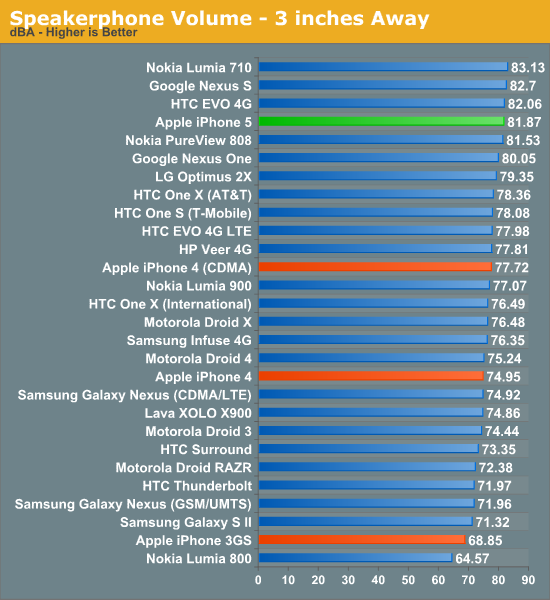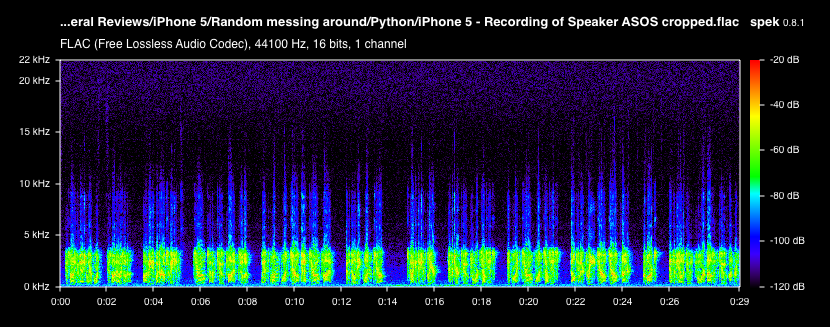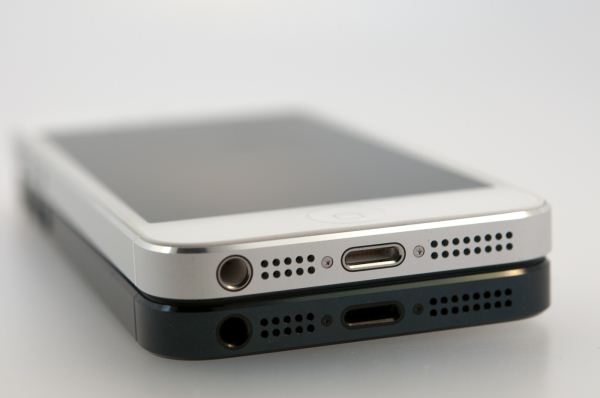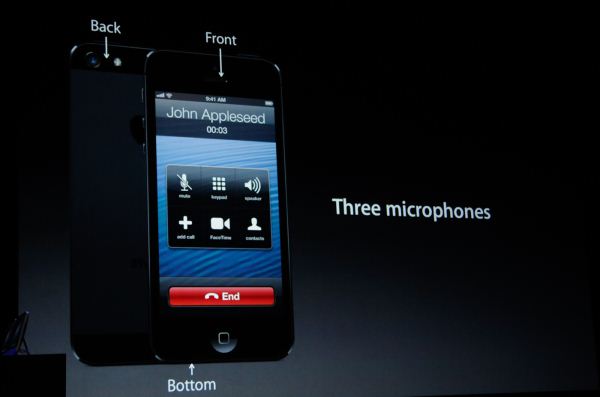The iPhone 5 Review
by Anand Lal Shimpi, Brian Klug & Vivek Gowri on October 16, 2012 11:33 AM EST- Posted in
- Smartphones
- Apple
- Mobile
- iPhone 5
Speakerphone and Noise Suppression
Section by Brian Klug
When Apple changed up the dock connector with the smaller Lightning port, it afforded a chance to also redesign the speakerphone at the bottom of the iPhone 5. Between the iPhone 4 and 4S we saw minimal changes, and performance was acceptable if a bit on the quiet side. With the iPhone 5 Apple advertised a big gain in audio quality with both changes to the speaker and a 5 magnet transducer design.
We normally test speakerphones by calling the local ASOS test number at max volume in front of an Extech sound data logger sampling continually and then averaging over one readout of the weather report. This gives a good feel for the overall loudness of the speakerphone on a call, but doesn’t tell us anything about quality unless you’re standing in front of it. In this case, the iPhone 5 is quite loud and comes in near the top of our scale at 81.8 dBA. It isn’t chart topping but a definite improvement over the relatively quiet 4/4S speakerphone design.

I decided to do something different though after getting a lot of questions and emails asking for a better quality comparison between the iPhone 5 speaker and its predecessor. People are interested in using their smartphones to listen to music when speakers or a dock aren’t available, and I thought this worth investigating. To get to the bottom of this I used my Blue Yeti USB microphone and arm which I use for podcasting to record the speakerphone output at 90 percent volume on the iPhone 4S and iPhone 5.
I started with the test call, which sounds surprisingly different between the iPhone 4S and iPhone 5. The 4S saturates and has obvious distortion even at 90 percent volume. This is quite noticeable in the recording. It then occurred to me that because I’m calling over AT&T (narrowband AMR) and to a PSTN (public switched telephone network) that the call would be limited to 4 kHz thanks to filters along the route, therefore anything above 4 kHz is undesirable. I took a spectral analysis (which shows power spectral density), and instantly it became obvious just how much energy there is on the 4S above the 4kHz limit from overmodulation or saturation/clipping on that speakerphone design. Meanwhile the iPhone 5 has much less energy over that 4 kHz maximum for a PSTN call.
I did the same for two songs recorded start to finish, and the differences are quite noticeable even in my rather quick and dirty recording plus spectogram comparison. I cropped the two recordings of the songs quite a bit and stuck them on soundcloud.

My overall impressions with the iPhone 5 speakerphone is that it has much less of a tendency to clip and saturate than the 4S, all while being noticeably louder. It’s still a smartphone speakerphone but to my ears the difference is pretty dramatic.
Noise Suppression
We’ve known for a while now that Apple changed up the slot for noise cancellation in the iPhone 5. The story goes something like this — Audience was a discrete chip on the iPhone 4, an IP block on the A5 SoC for iPhone 4S, and also an IP block onboard the A6 SoC for iPhone 5. The difference is that with iPhone 5 Audience isn’t enabled, and the company knows this because final characterization with both the final industrial design, microphones, and performance was never performed. Audience claims it met all of its deliverables and targets with the new IP block it built and gave Apple for inclusion on the A6. There’s obviously a lot of speculation about exactly why Apple chose to go with its own soultion versus Audience.
We’ve seen Audience earSmart noise suppression processors in a number of smartphones to date, and carriers often have their own specification for noise suppression to get certified. In addition, with wideband voice (AMR-WB in the case of the iPhone 5) noise suppression is even more important, to say nothing of how big of a topic this is with voice recognition based features like Siri. While we’re on the subject of AMR-WB, this feature is enabled on the iPhone 5 but I’m unable to test it on any of the carriers in the USA at the moment.
Anyhow, the iPhone 5 uses an Apple-specific solution with three total microphones all around the device. One primary microphone at the bottom of the device where you’d expect the primary microphone to reside, a secondary microphone between the LED flash and camera module, and a third right next to the earpiece for use with earpiece active noise cancelation. Apple’s solution is a beamformer (Apple said so in the keynote) and from what I can tell thus works entirely in the time domain. I’ve spent a lot of time playing around with the iPhone 5 trying to characterize its noise rejection, and the system appears to have a number of modes it will kick into after a 5–10 second adaptation time.
Earpiece noise rejection is something I talked about on the podcast right after the iPhone 5 hands on, and is one of those modes that the iPhone 5 will kick into if you’re in a loud environment. It isn’t active all the time, but when it does transition into working it provides a noticeable suppression of ambient noise and the same kind of pressure I’ve felt with other active noise canceling closed ear headphones. The improvement isn’t overwhelming, but it’s a sensation and feature I haven’t experienced on any other smartphones to date.
The rest of the noise suppression story is really one of testing. To test, I ran our normal test suite which consists of me ramping ambient music to 94 dBA while speaking into the device under test and recording the other side of the call. I’ve gotten ahold of the industry standard babble and distractor tracks used by carriers for testing noise suppression and will move to those in the future, for now though the test track I currently play is something I understand pretty well.
The comparison here is between the iPhone 4S and iPhone 5 to see just how ambient noise suppression has changed with this change in solution. The difference in technique is pretty apparent, and again indicates to me that the iPhone 5 is working in the time domain. You can see visible cut in and cut out on the waveform. The Audience solution has some hiss that develops at the absolute highest background noise volume on the 4S, but it also does an excellent job suppressing noise. The Apple solution doesn’t have this hiss, but passes both background noise and vocals from the music passed through the call at maximum volume. I hate to call this a regression, but the difference in technique means that there’s audible background noise that gets passed on while I’m talking on the iPhone 5. I think for normal callers the difference won’t be readily apparent, but with close inspection it is dramatic.













276 Comments
View All Comments
doobydoo - Friday, October 19, 2012 - link
'Right, so if you have good vision, like I do, then at a foot away, you can see those pixels.'If you can see that then you would also be capable of observing that the SG3 doesn't have full pixels, it uses a PenTile display which overall has fewer sub pixels over a greater area than the iPhone 5 screen, making it both absolutely lower quality and relatively lower quality per area.
KoolAidMan1 - Friday, October 19, 2012 - link
You can discern individual pixels on an iPhone 5 display?Lies.
dsumanik - Wednesday, October 17, 2012 - link
Im sure this guy said the same thing when the 4 came out...3.5 was "big enough"Just watch when apple adds an even bigger screen he will be saying it is "perfect"
The problem with iSheeps is that they need to get out there and actually use a different phone from a different ecosystem for a month, then switch back.
Apple's devices are well built and tightly integrated, but there are serious shortcomings, drawbacks, and flaws that you will notice once you return to the platform.
That said,
Personally i purchase apple products due to the insanely high resale value, which allows me to keep up with new gear on a yearly basis for a reasonable price.
Sent from my iphone 5
khurtwilliams - Thursday, October 18, 2012 - link
"iSheeps"? Must you resort to name calling to make your point?rarson - Thursday, October 18, 2012 - link
"Personally i purchase apple products due to the insanely high resale value, which allows me to keep up with new gear on a yearly basis for a reasonable price."I don't see it. Maybe if you buy the newest thing as soon as it comes out and sell your old last-gen device that most people are still happy with, then you're selling it for a decent amount, but you're still spending way more money than any reasonable person would. There's absolutely no monetary argument to buy Apple products, because if money is your concern, then you shouldn't be buying them in the first place.
Apple's phone prices are much closer in line with their hardware; for laptops and desktops, the resale value argument goes WAY out of whack.
darwiniandude - Friday, October 19, 2012 - link
I bought an early 2011 MBP last year for $2650 AUD. got a high res screen option etc. I heard rumours of the retina model and sold it just before the 12 months was up so the new purchaser still had a little warranty me could buy AppleCare if they wished. I sold it for $2300 AUD. This means I lost $350 over the year, it cost me $350 to have that machine for a year. I didn't buy AppleCare ($429 AUD) either.The retina model came out, and retailed for $2499 AUD
I've been doing this since my first Mac, in 2006. I can't believe the crazy used prices on Macs especially if they are still current model and about a year old. I pay about $300-$400 a year to have the latest and greatest and a machine that is always in warranty. If I bought a cheap PC notebook for $400 I'd be suffering with an underpowered plastic machine with little ram, no SSD, and it might last more than a year but I wouldn't be happy with it anyway. Each to their own. I could never stay current with PCs because a year later the system was next to worthless, even if I'd put a $1000 video card in it at the time. (I now, reluctantly, game on consoles or a little in bootcamp)
david22 - Thursday, October 18, 2012 - link
"there are serious shortcomings, drawbacks, and flaws"So what are they?
The problem with trolls is that they just spout bull.
MobiusStrip - Friday, October 19, 2012 - link
Apple refuses to pull its head out of its ass or LEARN. One profound impediment to making iOS devices useful is Apple's ridiculous fear, which you can see in its crippled SDK. One example: the lack of developer access to the dock port.But then there is just plain stupidity. There's no excuse for bullshit like this: http://goldmanosi.blogspot.com/2012/06/will-apple-...
darwiniandude - Friday, October 19, 2012 - link
Um, when someone calls me and I miss the call, iPhone shows a missed call. Then my carrier (Telstra) sends me a text message "You have a missed call from 0412xxxxxx" then "Please call 101 you have 1 new voicemail(s)"I get multiple alerts for both those SMS messages.
rex251 - Sunday, October 21, 2012 - link
Why going all the way in calling people that like apple products as sheeps?I think you should accept the fact that some people like small phones, and maybe like small smartphones, which neither iphone5 or sgs3 are.
From my perspective iphone 4/4s screen was maximum I would go with something called phone into my pocket, but I do not, instead finding xperia mini great sized, although too thick.
My point, why would we have to considere as progress only bigger screen phones as such, we do have plenty of tablets to pick from for that usage?